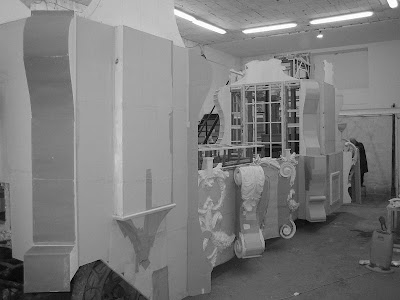 In questi giorni nel laboratorio si creano e si aggiungono i decori in cartapesta. Ecco Michele ed Elena al lavoro.
In questi giorni nel laboratorio si creano e si aggiungono i decori in cartapesta. Ecco Michele ed Elena al lavoro.In these days Michele and Elena are making and adding to the cart the paper machè statues and decorations.
Questo blog segue la costruzione del Carro Trionfale della Festa della Bruna - Matera - 2007. This blog is documenting the "Carro della Bruna" building process.


Nella foto: statue già pronte. Queste saranno fissate sulla parte posteriore del carro, una volta che sarà terminata la struttura portante, e verranno decorate.
Nella foto a destra i personaggi così come sono nel bozzetto di M. Pentasuglia.
Si è a metà del lavoro per quanto riguarda la preparazione della struttura.
Volendo fare un elenco preciso dei diversi passaggi ad ora attuati nella realizzazione del carro ecco qui di seguito le diverse fasi:
1. Un falegname (Angelo Chico) realizza una struttura in legno leggero che viene montata sulla struttura fissa del carro, la quale a sua volta è ben salda al meccanismo in ferro che muove tutta la macchina del carro.
(ricordiamo che la struttura realizzata dal falegname Angelo, sarà strappata via durante l’assalto al carro nella sera del 2 luglio)
2. Si “incarta” il carro con cartoncino poroso e colla vinilica.
2.1 Al contempo altri elementi in legno creati per arricchire il carro (ad esempio cupole) vengono preparati e tenuti da parte.
2.2 Sempre a parte vengono realizzate le statue in cartapesta, i bassorilievi, vasi, e tutte quelle parti che saranno l’ornato del carro.
3. Una volta “incartato”, il carro viene decorato con i bassorilievi e gli altorilievi preparati in precedenza.
3.1 Si preparano le cornici nelle quali saranno dipinti paesaggi, delle scene pastorali o eventi i tratti dal vangelo.
 Elena sta preparando le decorazioni del carro fatte utilizzando gli stampi creati da Michelangelo o appartenuti anche al papà ed al nonno di Michelangelo.
Elena sta preparando le decorazioni del carro fatte utilizzando gli stampi creati da Michelangelo o appartenuti anche al papà ed al nonno di Michelangelo.
 - si comincia con della carta bianca sottile. Si passa della colla da parati preparata in precedenza su delle strisce di carta. La carta sottile aderisce meglio allo stampo ed in tal modo prende subito la forma dello stampo stesso.
- si comincia con della carta bianca sottile. Si passa della colla da parati preparata in precedenza su delle strisce di carta. La carta sottile aderisce meglio allo stampo ed in tal modo prende subito la forma dello stampo stesso. - Si aggiungono due strati di carta insieme, uno marrone di carta più doppia per conferire spessore ed un altro di carta bianca per poter contare i diversi strati.
- Si aggiungono due strati di carta insieme, uno marrone di carta più doppia per conferire spessore ed un altro di carta bianca per poter contare i diversi strati.
...in the meantime Angelo is creating more wooden structures to be added to the cart in order to embellish it.
There are two young and hard-working people? Who are they? What are they doing?We will tell about them in the following posts.

 I fratelli Francesco e Raffaele Pentasuglia - 1947
I fratelli Francesco e Raffaele Pentasuglia - 1947 I fratelli Francesco e Raffaele Pentasuglia nel 1934
I fratelli Francesco e Raffaele Pentasuglia nel 1934 Raffaele Pentasuglia - 1923
Raffaele Pentasuglia - 1923


 Angelo Chico sta preparando la struttura in legno che reggerà il lavoro in cartapesta del maestro Michelangelo Pentasuglia.
Angelo Chico sta preparando la struttura in legno che reggerà il lavoro in cartapesta del maestro Michelangelo Pentasuglia.

 Foto gentilmente concessa da Uccio Santochirico
Foto gentilmente concessa da Uccio Santochirico


